Power washing your deck will remove all the dirt, grime, and mold built over time.
It will also help brighten the wood and restore its natural color.
If you do it regularly (every few months), it will help to protect your deck from rot and decay.
Power washing is a quick and easy way to improve the look of your deck – and it’s not as expensive as you might think!
So if you’re looking for a way to give your deck a fresh new look, be sure to consider power washing!
If you have a deck, you know it needs to be cleaned every once in a while. But cleaning a deck can be a real pain, and it’s definitely worth the effort, especially if you want to keep your home looking sharp.
In this post, we’ll show you how to power wash a deck and give tips for getting the job done right. So read on and get ready to tackle that dirty deck!
Best Time To Wash A Deck
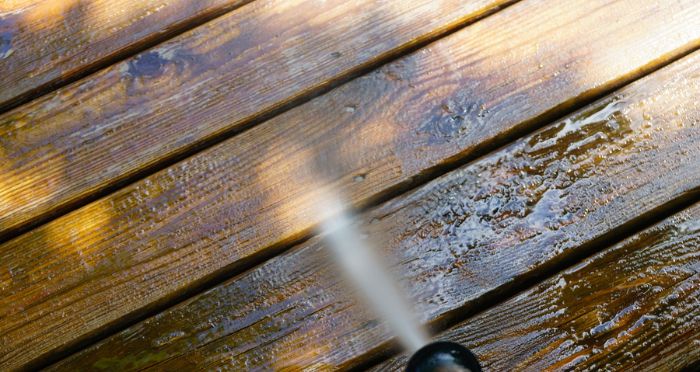
The best time to pressure wash your deck is after the fall and before the spring.
This way, you’ll be able to clean off all of the dirt and grime that accumulated throughout winter without worrying about pesky moss or mold growth. It’s also a good idea to wait until summer has passed. So you can remove any unwanted spiders, insects, or other pests that might have taken up residence during those hot months.
Not only will this help keep your deck looking nice for years to come, but it will also prevent these unwelcome guests from returning next year!
Is It Safe to Power Wash a Deck?
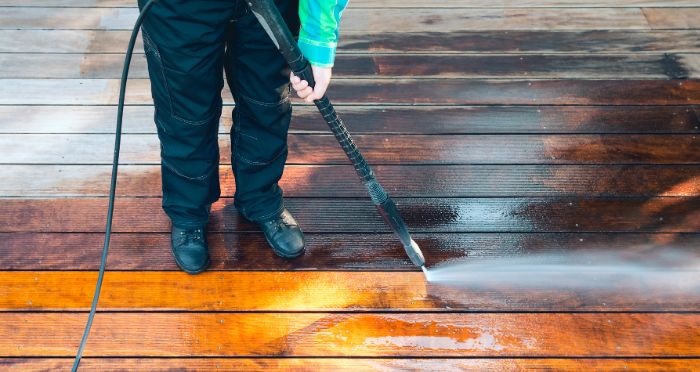
It’s pretty alright to pressure wash a deck, as long as you follow the necessary precautions.
However, you risk injuring the decking if you use a pressure washer with a PSI more significant than 1500. Scratching, splintering, or breaking may occur as a result of this.
For softwoods like cedar or pine, the optimum PSI for your deck is 500-600. For harder woods, you could go higher but not beyond 1200 PSI.
Set Up and Test
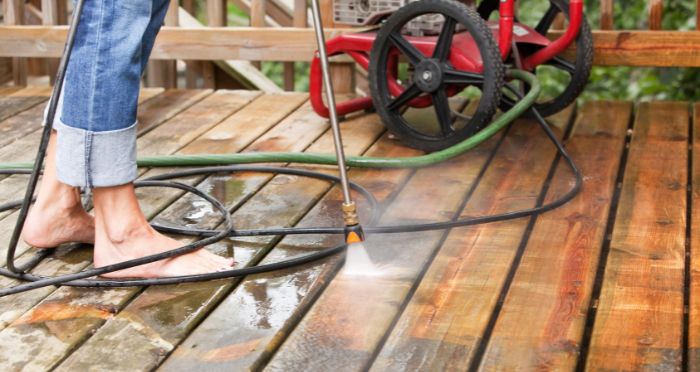
Choose a Pressure and Tip Setting
If your deck is filthy, you’ll need to use a pressure setting that’s high enough to blast away at the dirt. For light cleaning, use a lower setting.
Use the least amount of force that is still effective. For example, softwood (like cedar or pine) should be pressurized to a minimum of 500 to 600 psi; harder woods may tolerate more pressure, but it’s unwise to go past 1,200 psi.
Select a Tip: if your deck is heavily stained with mold, mildew, or grime, you might want to consider using a brush tip for more thorough coverage. A fan tip with a 40- to 60-degree spread is ideal. A rotating tip may also be used if handled correctly.
Examine the Pressure Washer Settings
The other important part of pressure washing your deck is the setting to clean it. Depending on what you’re cleaning off, you may need to adjust the pressure if the build-up is light or heavy.
Begin with 500 to 600 psi pressure. Then, increase the pressure gradually until you identify the ideal cleaning pressure.
Keep Your Home and Plants Safe
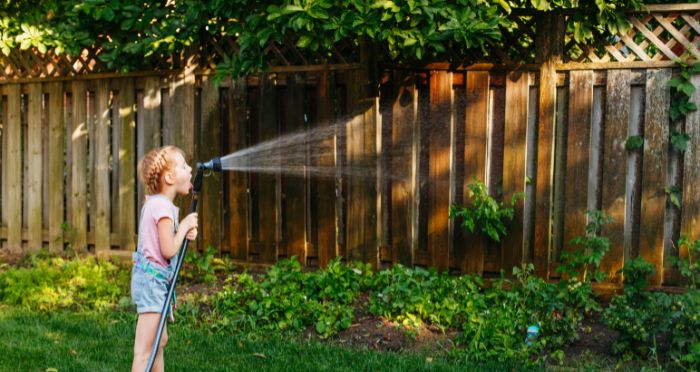
Before you begin power washing your deck, it’s important to ensure it is in good repair. That means replacing any cracked or split boards and repairing any broken balusters. It’s also important to heavily douse the plants or grass under and around your deck with water and cover them with plastic.
Most power washing strippers aren’t harmful to vegetation, but it’s always better to be safe than sorry. Once you’ve finished power washing the deck, immediately remove the plastic.
It would be best if you also sprayed down the siding of your house with clean water to ensure that any stripper that splashes onto the house will easily wash off.
By following these simple steps, you can power wash your deck safely.
How To Power Wash A Deck
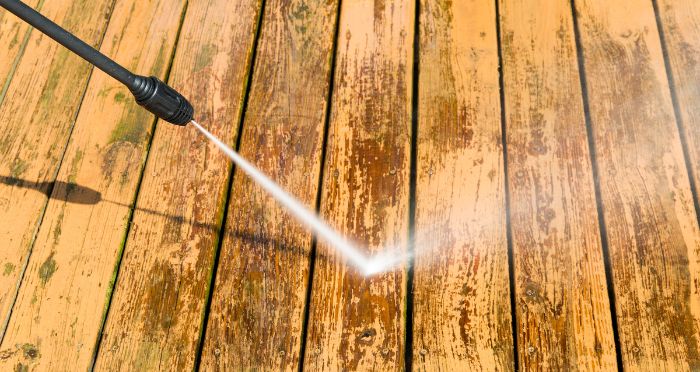
Here are some steps to ensure your deck is power washed correctly every time.
Step 1: Wash the Railings
Pressure wash the railings using a stripper. Start at the top and work your way down, keeping the tip 6 to 10 inches away from the wood. Spray balusters are positioned at the corners to clean two sides simultaneously.
Step 2: Power Wash the Deck
To ensure your deck is as clean as possible, you’ll need to invest in a good pressure washer. It’s essential to ensure that the pressure release power is high enough for this job.
If you need a light cleaning, it’s probably best to use a lower setting. However, you will want to use a higher setting for dirty decks that have been collecting mold, mildew, and grime for a long time.
Working on one section of your deck at a time is always a good idea so you don’t accidentally spread dirt from one area onto another.
Ensure that the correct type of tip is being used with your power washer- if it needs heavy.
Step 3: Remove any debris from the gaps between deck boards
With a putty knife, dig out trapped debris between deck boards. Then, spray the deck with oxalic acid and water to brighten it up.
Apply the stripper to the deck. Start with the top rails and work down the balusters. Use a 25- or 30-degree tip on the pressure washer’s wand and a PSI of 1,000 to 1,200. Spray the rails in a continuous, organized manner with the wand. You don’t want to scratch the wood by moving too quickly.
Start with the deck boards once you’ve completed the railings. First, wash down the length of the boards. Then wash the grime away from the wood.
Rather than increasing the pressure or heavily scrubbing the wood, go over stubborn mildew or other marks a few times. Later, we’ll deal with hard stains that won’t come off with the stripper.
The lignin removal in this stripping process washes away a tiny amount of the wood’s glue, which binds the wood fibers together. As a result, the fibers stand up as the lignin washes away, giving the wood a fuzzy texture. Don’t bother sanding the fuzzy fibers. They will eventually shear away, leaving only the smooth ones.
After you’ve finished power-washing the whole deck, rinse all of the wood with plain water to remove any remaining stripper. Next, remove any debris trapped between deck boards, such as leaves or twigs, if there is still any.
Step 4: Apply a Chemical Stripper/Brightener (Optional)
Stains are not the only reason to clean your deck. Deck surfaces can also get dark, dull, or moldy over time despite regular cleaning. If this is the case, you may want to consider applying a chemical stripper/brightener. The wood will need to be left to dry for several hours before being ready for staining.
Step 5: Examine the whole deck and repair any loose boards
Remove any nails or screws that may be sticking out. Replace any missing or loose fasteners with longer screws at least 1/2″ longer than the original. Identifying areas that require more attention when the deck is clean is simple.
Remove any nail heads that are emerging from the deck boards. Look for missing or loose screws and replace them with corrosion-resistant screws that are a little longer than the original. Replace rusted or missing nails with corrosion-resistant “trim head” screws, which have a considerable finish nail appearance and are tiny.
Check for loose lag screws or bolts in your ledger board, rails, or posts. Also, look for indications that the flashing between your deck and house has fallen out of place.
Recommended Pressure Washers
[amazon box=”B00N6XBM64″]
Read Full Review: AR Blue Clean AR390SS Review
[amazon box=”B00CPGMUXW”]
Read Full Review: Sun Joe SPX3000 Review
[amazon box=”B01BMETENG”]
Read Full Review: Karcher K5 Premium Review
Recommended Deck Stripper/Brightener
[amazon box=”B06Y29P334″]
[amazon box=”B00CFC0268″]
[amazon box=”B0062CWRHO”]
[amazon box=”B07LF8T6PM”]
[amazon box=”B06XGNJ95V”]
[amazon box=”B00AZNE68Y”]
Sanding After Washing
After you’ve pressure washed your deck, it’s important to sand it down before staining. Do this carefully so as not to damage the wood or remove any applied stains. You might want to wear a mask and goggles if any chemicals are involved in the process and wear gloves and long sleeves.
Take care when sanding. Don’t use too much pressure on anyone’s area. And be careful to hold the sander at a 45-degree angle with alternating horizontal and vertical motions for best results.
When sanding, use only medium sandpaper. Do not use fantastic sandpaper since it might clog the wood’s pores and prevent the stain/sealer from swiftly soaking in. Use no finer than 100-grit sandpaper on the handrail. 60- to 80-grit sandpaper is ideal for a wooden deck’s surface.
Recommended Sander
[amazon box=”B0000223IY”]
[amazon box=”B003M5IWM8″]
Pressure Washing Safety Tips
- Spray the water until you find a power level that works for you.
- You should not aim the wand at anything you don’t want to spray.
- Cover the exposed electrical outlets.
- Wear the appropriate safety equipment and clothing. Boots and gloves made of rubber will keep your hands and feet safe. Goggles, a disposable respirator or dust mask, and gloves will protect your eyes from the chemicals while keeping them from splashing into them.
- Keep the pressure washer’s exhaust at least 3 feet away from anything, especially your home.
Wrap Up - How To Power Wash A Deck
Now that you know how to power wash a deck, it’s time to get out there and give your home the TLC it deserves. Deck cleaning is not the most fun job, but it’s worth it if you want to keep your house looking sharp.
So put on some sunscreen and get to work!
FAQs
Is it better to power wash a deck or use a deck cleaner?
Answer: If you’re asking whether it’s better to power wash your deck or use a deck cleaner, the answer depends on a few factors. If you have a large deck, a pressure washer can clean it much faster than scrub it by hand.
However, if you have a small deck or your deck is particularly dirty, using a cleaner may be more effective. Regardless of your chosen method, follow the manufacturer’s instructions carefully to avoid damaging your deck.
Does power washing damage wood on a deck?
Answer: Power washing can remove the finish from a deck and the dirt, grime, and mold. It is important to use the correct pressure when cleaning a deck. Too much pressure can damage the wood and even strip off the paint or sealant.
Shop Related Products
[amazon bestseller=”pressure washer”]